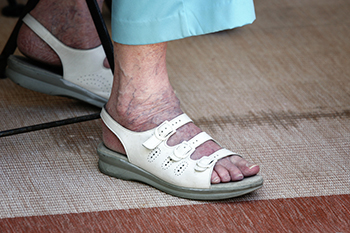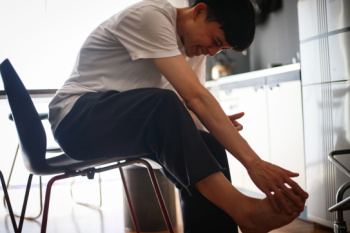Connect With Us
Blog

As people age, their feet often experience natural changes that can lead to discomfort and mobility issues. Thinning fat pads reduce cushioning, which can make walking and standing more painful. Osteoarthritis commonly develops, causing joint stiffness and swelling. Reduced circulation may result in cold feet, slow healing, and increased risk of infection. Many elderly individuals also experience decreased pain sensation, which can make it difficult to notice injuries or pressure sores. Regular foot care and attention from a podiatrist can help manage these conditions, improve comfort, and prevent complications. If you or a loved one are experiencing foot pain or changes, it is suggested that you schedule an appointment with a podiatrist who can treat various foot conditions, and guide you on how to maintain healthy, pain-free feet.
If you need your feet checked, contact Nadia Sadeghi, DPM of Lincoln Park Foot and Ankle Specialists. Our doctor will attend to all of your foot and ankle needs and provide you with quality treatment.
Geriatrics and Podiatry
When people age, some common issues that may occur are bone density loss, dry skin, poor circulation, and rough brittle nails. These issues may also affect your foot health if the necessary steps are not taken to alleviate the problems.
It is important to take care of your feet because feet that are injured or diseased can affect your overall health. Having painful feet hinders your ability to do daily activities or may decrease your willingness to do the things that you need to do.
Visiting Your Geriatrician
As we age, health problems become more likely, so it is essential to visit your doctor for check-ups to ensure that you are doing the best you can to take care of your health. It is recommended to check your feet frequently for any possible cuts, bruises, swelling, corns or any other irregularities.
Taking Care of Elderly Feet
Cracked or dry feet can be treated by applying moisturizer often. It is also important not to wear old socks because the older the sock is, the higher the possibility there will be that there is bacteria there. Wear fresh socks and make sure they fit properly.
Proper foot health means that you can have a more active lifestyle and you will not be bogged down by pain. Foot health also leads to good circulation, which is paramount for overall health.
If you have any questions, please feel free to contact our office located in Chicago, IL . We offer the newest diagnostic and treatment technologies for all your foot care needs.

Swollen feet occur when excess fluid builds up in the tissues of the lower extremities. This condition, termed edema, can result from standing or sitting for long periods but may also indicate underlying health concerns such as heart disease, kidney disease, liver disease, or chronic venous insufficiency. Swelling may cause discomfort, heaviness, or visible puffiness in the feet and ankles. A podiatrist can help determine the cause through a thorough evaluation and recommend treatment, such as compression therapy and circulation improvement. If your feet are consistently swollen, it is suggested that you consult a podiatrist who can provide an accurate diagnosis and offer effective relief tips.
Swollen feet can be a sign of an underlying condition. If you have any concerns, contact Nadia Sadeghi, DPM of Lincoln Park Foot and Ankle Specialists. Our doctor can provide the care you need to keep you pain-free and on your feet.
Swollen feet are a common ailment among pregnant women and people who stand or sit for extended periods. Aging may increase the possibility of swollen feet and patients who are obese often notice when their feet are swelling too. There may be medical reasons why swollen feet occur:
- Phlebitis - A condition that causes the veins to become inflamed and can also cause leg pain.
- Liver disease - This may lead to low blood levels of albumin which is a protein. This can cause fluid in the blood to pass into the tissues and several areas of the body can become swollen.
- Heart failure - When the heart doesn’t pump properly the blood that is normally pumped back to the heart can pool in the veins of the legs causing swollen feet.
- Kidney disease - One of the main functions of the kidneys is releasing excess fluid in the body. This type of condition can make it difficult for the kidneys to function properly, and as a result the feet may become swollen.
- Deep-vein thrombosis (DVT)- This is a serious condition where blood clots form in the veins of the legs. They can block the return of blood from the legs to the heart which may cause the feet to swell. It is important to be treated by a podiatrist if this condition is present.
Swollen feet can also be caused by bone and tendon conditions, including fractures, arthritis, and tendinitis. Additionally, there may be skin and toenail conditions and an infection may cause the feet to swell. Patients who take medicine to treat high blood pressure may be prone to getting swollen feet.
Many patients elevate their feet to help relieve the swelling and this is generally a temporary remedy. When a podiatrist is consulted the reason behind the swelling can be uncovered and subsequently treated.
If you have any questions please contact our office located in Chicago, IL . We offer the newest diagnostic and treatment technologies for all your foot and ankle needs.

Gout is a type of arthritis that develops when uric acid builds up in the bloodstream and forms sharp crystals in the joints. This often leads to sudden episodes of intense pain, redness, and swelling, most commonly in the big toe. The attacks can come on quickly, sometimes overnight, and may last for days if untreated. There are several factors that can raise the risk of gout. Triggers can include eating foods rich in purines, such as red meat, shellfish, and alcohol, which can increase uric acid levels. Being overweight, having kidney problems, or taking certain medications may also contribute. Additionally, family history plays a role as well, since some people naturally produce more uric acid or have more difficulty eliminating it. Lifestyle changes and proper medical care can reduce painful flares and prevent long-term joint damage. If you have joint pain that may be gout, it is suggested that you see a podiatrist for an evaluation and appropriate treatment.
Gout is a painful condition that can be treated. If you are seeking treatment, contact Nadia Sadeghi, DPM from Lincoln Park Foot and Ankle Specialists. Our doctor will treat your foot and ankle needs.
What Is Gout?
Gout is a form of arthritis that is characterized by sudden, severe attacks of pain, redness, and tenderness in the joints. The condition usually affects the joint at the base of the big toe. A gout attack can occur at any random time, such as the middle of the night while you are asleep.
Symptoms
- Intense Joint Pain - Usually around the large joint of your big toe, and it most severe within the first four to twelve hours
- Lingering Discomfort - Joint discomfort may last from a few days to a few weeks
- Inflammation and Redness -Affected joints may become swollen, tender, warm and red
- Limited Range of Motion - May experience a decrease in joint mobility
Risk Factors
- Genetics - If family members have gout, you’re more likely to have it
- Medications - Diuretic medications can raise uric acid levels
- Gender/Age - Gout is more common in men until the age of 60. It is believed that estrogen protects women until that point
- Diet - Eating red meat and shellfish increases your risk
- Alcohol - Having more than two alcoholic drinks per day increases your risk
- Obesity - Obese people are at a higher risk for gout
Prior to visiting your podiatrist to receive treatment for gout, there are a few things you should do beforehand. If you have gout you should write down your symptoms--including when they started and how often you experience them, important medical information you may have, and any questions you may have. Writing down these three things will help your podiatrist in assessing your specific situation so that he or she may provide the best route of treatment for you.
If you have any questions, please feel free to contact our office located in Chicago, IL . We offer the newest diagnostic and treatment technologies for all your foot care needs.

